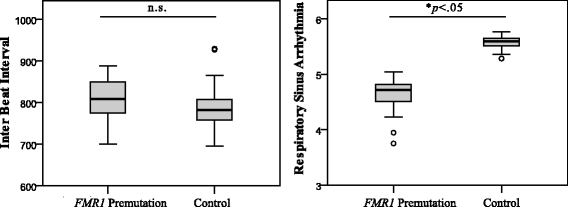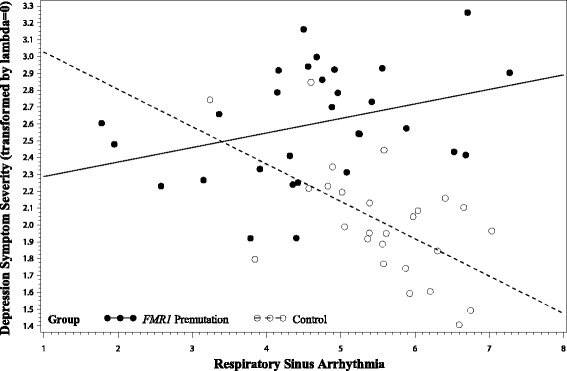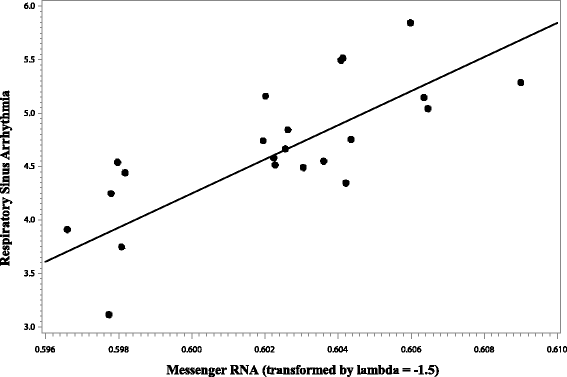Reduced vagal tone in women with the FMR1 premutation is associated with FMR1 mRNA but not depression or anxiety
- PMID: 28469730
- PMCID: PMC5414146
- DOI: 10.1186/s11689-017-9197-6
Reduced vagal tone in women with the FMR1 premutation is associated with FMR1 mRNA but not depression or anxiety
Abstract
Background: Autonomic dysfunction is implicated in a range of psychological conditions, including depression and anxiety. The fragile X mental retardation-1 (FMR1) premutation is a common genetic mutation that affects ~1:150 women and is associated with psychological vulnerability. This study examined cardiac indicators of autonomic function among women with the FMR1 premutation and control women as potential biomarkers for psychological risk that may be linked to FMR1.
Methods: Baseline inter-beat interval and respiratory sinus arrhythmia (a measure of parasympathetic vagal tone) were measured in 35 women with the FMR1 premutation and 28 controls. The women completed anxiety and depression questionnaires. FMR1 genetic indices (i.e., CGG repeat, quantitative FMRP, FMR1 mRNA, activation ratio) were obtained for the premutation group.
Results: Respiratory sinus arrhythmia was reduced in the FMR1 premutation group relative to controls. While depression symptoms were associated with reduced respiratory sinus arrhythmia among control women, these variables were unrelated in the FMR1 premutation. Elevated FMR1 mRNA was associated with higher respiratory sinus arrhythmia.
Conclusions: Women with the FMR1 premutation demonstrated autonomic dysregulation characterized by reduced vagal tone. Unlike patterns observed in the general population and in study controls, vagal activity and depression symptoms were decoupled in women with the FMR1 premutation, suggesting independence between autonomic regulation and psychopathological symptoms that is atypical and potentially specific to the FMR1 premutation. The association between vagal tone and mRNA suggests that molecular variation associated with FMR1 plays a role in autonomic regulation.
Keywords: FMR1 mRNA; FMRP; Fragile X carriers; Heart rate; Physiological arousal; Vagal tone.
Figures



Similar articles
-
Indicators of anxiety and depression in women with the fragile X premutation: assessment of a clinical sample.J Intellect Disabil Res. 2010 Jul;54(7):597-610. doi: 10.1111/j.1365-2788.2010.01290.x. J Intellect Disabil Res. 2010. PMID: 20629912
-
Preliminary evidence of an effect of cerebellar volume on postural sway in FMR1 premutation males.Genes Brain Behav. 2015 Mar;14(3):251-9. doi: 10.1111/gbb.12204. Epub 2015 Mar 25. Genes Brain Behav. 2015. PMID: 25689687
-
Presence of inclusions positive for polyglycine containing protein, FMRpolyG, indicates that repeat-associated non-AUG translation plays a role in fragile X-associated primary ovarian insufficiency.Hum Reprod. 2016 Jan;31(1):158-68. doi: 10.1093/humrep/dev280. Epub 2015 Nov 3. Hum Reprod. 2016. PMID: 26537920 Free PMC article.
-
[FMR1 PREMUTATION CARRIERS - ARE THEY REALLY ASYMPTOMATIC?].Harefuah. 2018 Apr;157(4):241-244. Harefuah. 2018. PMID: 29688643 Review. Hebrew.
-
Fragile X syndrome and fragile X-associated tremor ataxia syndrome.Handb Clin Neurol. 2018;147:377-391. doi: 10.1016/B978-0-444-63233-3.00025-7. Handb Clin Neurol. 2018. PMID: 29325626 Review.
Cited by
-
Maternal Mental Health and Parenting Stress and Their Relationships to Characteristics of the Child With Fragile X Syndrome.Front Psychiatry. 2021 Nov 24;12:716585. doi: 10.3389/fpsyt.2021.716585. eCollection 2021. Front Psychiatry. 2021. PMID: 34899411 Free PMC article.
-
Cardiovascular Problems in the Fragile X Premutation.Front Genet. 2020 Oct 8;11:586910. doi: 10.3389/fgene.2020.586910. eCollection 2020. Front Genet. 2020. PMID: 33133171 Free PMC article.
-
Early behavioral and physiological markers of social anxiety in infants with fragile X syndrome.J Neurodev Disord. 2021 Mar 20;13(1):11. doi: 10.1186/s11689-021-09356-3. J Neurodev Disord. 2021. PMID: 33743580 Free PMC article.
-
Low normal FMR1 genotype in older adult women: Psychological well-being and motor function.Arch Gerontol Geriatr. 2022 Nov-Dec;103:104789. doi: 10.1016/j.archger.2022.104789. Epub 2022 Aug 12. Arch Gerontol Geriatr. 2022. PMID: 35981426 Free PMC article.
-
Atypical vocal quality in women with the FMR1 premutation: an indicator of impaired sensorimotor control.Exp Brain Res. 2023 Aug;241(8):1975-1987. doi: 10.1007/s00221-023-06653-2. Epub 2023 Jun 22. Exp Brain Res. 2023. PMID: 37347418 Free PMC article.
References
-
- Lovallo WR. Stress and health: Biological and psychological interactions. 3. Tousand Oaks: Sage Publications; 2015.
-
- Jänig W, McLachlan EM. Autonomic Failure: A Textbook of Clinical Disorders of the Autonomic Nervous System Oxford. 2013. Neurobiology of the autonomic nervous system; pp. 21–34.
Grants and funding
LinkOut - more resources
Full Text Sources
Other Literature Sources

